测控系统原理及设计_new
- 格式:ppt
- 大小:10.54 MB
- 文档页数:55
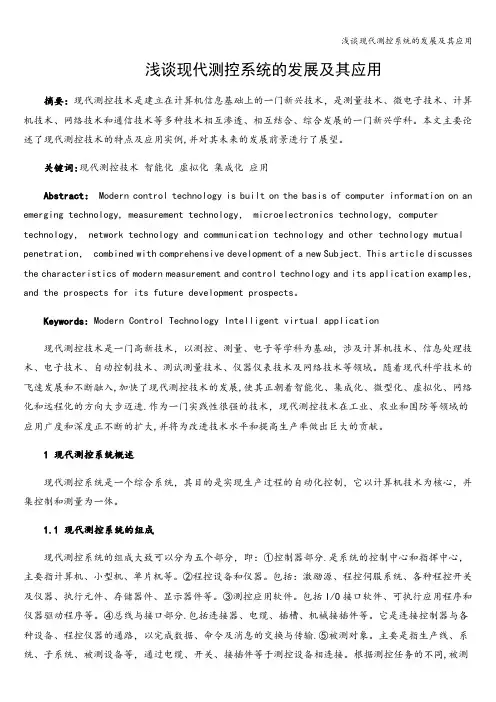
浅谈现代测控系统的发展及其应用摘要:现代测控技术是建立在计算机信息基础上的一门新兴技术,是测量技术、微电子技术、计算机技术、网络技术和通信技术等多种技术相互渗透、相互结合、综合发展的一门新兴学科。
本文主要论述了现代测控技术的特点及应用实例,并对其未来的发展前景进行了展望。
关键词:现代测控技术智能化虚拟化集成化应用Abstract: Modern control technology is built on the basis of computer information on an emerging technology, measurement technology, microelectronics technology, computer technology, network technology and communication technology and other technology mutual penetration, combined with comprehensive development of a new Subject. This article discusses the characteristics of modern measurement and control technology and its application examples,and the prospects for its future development prospects。
Keywords: Modern Control Technology Intelligent virtual application现代测控技术是一门高新技术,以测控、测量、电子等学科为基础,涉及计算机技术、信息处理技术、电子技术、自动控制技术、测试测量技术、仪器仪表技术及网络技术等领域。
随着现代科学技术的飞速发展和不断融入,加快了现代测控技术的发展,使其正朝着智能化、集成化、微型化、虚拟化、网络化和远程化的方向大步迈进.作为一门实践性很强的技术,现代测控技术在工业、农业和国防等领域的应用广度和深度正不断的扩大,并将为改进技术水平和提高生产率做出巨大的贡献。
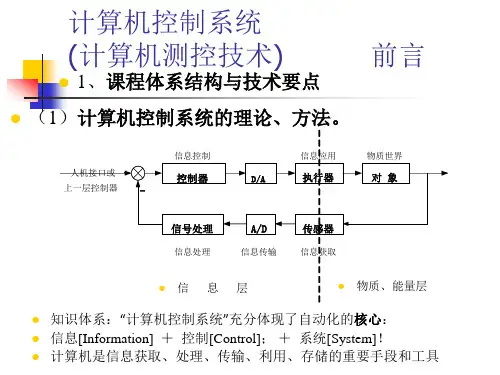
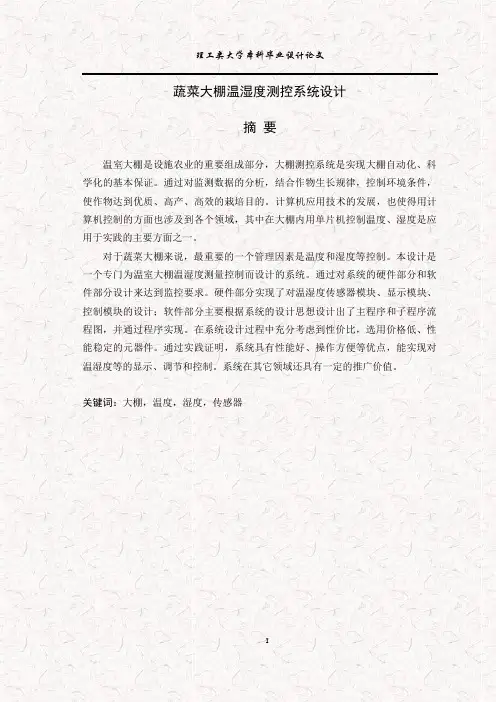
蔬菜大棚温湿度测控系统设计摘要温室大棚是设施农业的重要组成部分,大棚测控系统是实现大棚自动化、科学化的基本保证。
通过对监测数据的分析,结合作物生长规律,控制环境条件,使作物达到优质、高产、高效的栽培目的。
计算机应用技术的发展,也使得用计算机控制的方面也涉及到各个领域,其中在大棚内用单片机控制温度、湿度是应用于实践的主要方面之一。
对于蔬菜大棚来说,最重要的一个管理因素是温度和湿度等控制。
本设计是一个专门为温室大棚温湿度测量控制而设计的系统。
通过对系统的硬件部分和软件部分设计来达到监控要求。
硬件部分实现了对温湿度传感器模块、显示模块、控制模块的设计;软件部分主要根据系统的设计思想设计出了主程序和子程序流程图,并通过程序实现。
在系统设计过程中充分考虑到性价比,选用价格低、性能稳定的元器件。
通过实践证明,系统具有性能好、操作方便等优点,能实现对温湿度等的显示、调节和控制。
系统在其它领域还具有一定的推广价值。
关键词:大棚,温度,湿度,传感器The Design of Greenhouse Temperature andHumidity Control SystemABSTRACTGreenhouse is an important component of protected agriculture. Measuring and controlling systen is the basis of the management automation in the greenhouse. With the growth rules analyzing measurement data and controlling circumstance condition. It makes greenhouse better, and more productive and high quality. With the development of computer application technology, the computer-controlled areas are also involved, the plastic temperature using SCM and humidity is one of the main aspects used in practice. For vegetable shed speaking, one of the most important management factor is the temperature and humidity control. The thesis is about an intelligent system designed for controlling the temperature and humidity of a greenhouse. It can meet the demand of monitoring through the design of hardware and that of software in details. The former is more important in this dissertation, including the introduction of sensor of measuring temperature and humidity, demonstrating mode of data, the mode of control and the connecting part of the changing column. And according to the design thoughts the latter shows the flow chart of the main program and the subprogram, realized by program. This thesis choose the decices as full consideration of the ration between prformance and cost as possible. The system adopts quite a new integrated circuit, which makes it function better and run more conveniently when put into practice. Furthermore, not only can it achieve the goals of manifesting and regulating the temperature, but also it can be controlled. And it has much of value to apply and popularize in other fields.KEY WORDS:Vegetable, Temperature, Humidity, Sensor目录前言 (1)第1章设计方案论证 (2)1.1 设计要求及框图 (2)1.2 元器件的选择 (2)1.2.1 单片机的选择 (2)1.2.2 温度传感器的选择 (3)1.2.3 湿度传感器的选择 (3)1.2.4 显示模块的选择 (4)1.2.5 系统设计方案的确定 (4)第2章系统的硬件设计 (6)2.1 系统硬件的简述 (6)2.2 单片机模块的设计 (6)2.2.1 单片机的功能特性描述 (6)2.2.2 单片机的最小系统 (8)2.3 温湿度采集系统的设计 (9)2.3.1 温湿度传感器的概述 (9)2.3.2 传感器的接口说明 (9)2.3.3 硬件连接 (10)2.4 显示模块的设计 (10)2.4.1 LCD12864的概述 (10)2.4.2 LCD12864引脚说明 (12)2.4.3 LCD12864的主要技术参数 (13)2.5 报警电路的设计 (14)2.6 功能键的设计 (15)2.7 控制电路的设计 (15)第3章软件系统设计 (17)3.1 软件设计的整体思想 (17)3.2 程序流程图设计 (17)3.3 DHT90软件系统设计 (18)3.3.1 DHT90测量流程图 (18)3.3.2 传感器的电气特性 (20)3.3.3 启动传感器指令 (20)3.3.4 发送命令 (21)3.3.5 测量时序 (21)3.3.6通讯复位时序 (21)3.4 DHT90的温湿度补偿及转换 (22)3.4.1 相对湿度 (22)3.4.2 温度转换 (22)3.5 LCD12864软件系统设计 (23)3.5.1 LCD12864显示流程图 (23)3.5.2 写数据到模块 (24)3.5.3 从模块读出数据 (25)3.6 按键软件系统设计 (26)第4章调试 (28)4.1 软件调试 (28)4.2 硬件调试 (28)4.3 液晶模块调试 (29)4.4 报警电路调试 (29)结论 (30)谢辞 (31)参考文献 (32)附录 (33)外文资料翻译 (46)前言改革开放以来,我国经济的迅速增长,使得农业的研究和应用技术越来越受到重视,特别是温室大棚已经成为高效农业的一个重要组成部分。
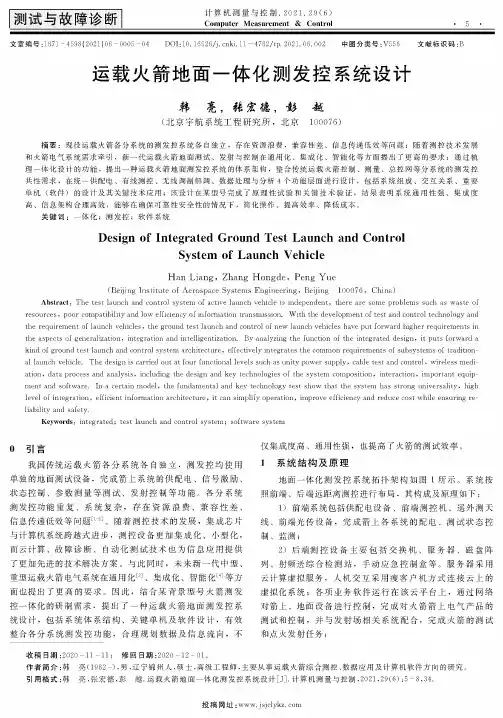
5测试与故障诊断计算机测量与控制■ 2021. 29 (6)Computer Measurement & Control文章编号:1671 - 4598(2021)06 - 0005 -04 DOI :10. 16526/j. cnki. 11 —4762/tp. 2021. 06.002 中图分类号:V556 文献标识码:B运载火箭地面一体化测发控系统设计韩亮,张宏德,彭越(北京宇航系统工程研究所,北京100076)摘要:现役运载火箭各分系统的测发控系统各自独立,存在资源浪费,兼容性差、信息传递低效等问题;随着测控技术发展 和火箭电气系统需求牵引,新一代运载火箭地面测试、发射与控制在通用化、集成化、智能化等方面提出了更高的要求;通过梳 理一体化设计的功能,提出一种运载火箭地面测发控系统的体系架构,整合传统运载火箭控制、测量、总控网等分系统的测发控共性需求,在统一供配电、有线测控、无线调制解调、数据处理与分析4个功能层面进行设计,包括系统组成、交互关系、重要 单机(软件)的设计及其关键技术应用;该设计在某型号完成了原理性试验和关键技术验证,结果表明系统通用性强、集成度高、信息架构合理高效,能够在确保可靠性安全性的情况下,简化操作、提高效率、降低成本。
关键词:一体化;测发控;软件系统Design of Integrated Ground Test Launch and ControlSystem of Launch VehicleHan Liang ,Zhang Hongde ,Peng Yue(Beijing Institute of Aerospace Systems Engineering ,Beijing 100076, China)Abstract : The test launch and control system of active launch vehicle is independent ,there are some problems such as waste ofresources ,poor compatibility and low efficiency of information transmission. With the development of test and control technology andthe requirement of launch vehicles ,the ground test launch and control of new launch vehicles have put forward higher requirements in the aspects of generalization ,integration and intelligentization. By analyzing the function of the integrated design, it puts forward a kind of ground test launch and control system architecture ,effectively integrates the common requirements of subsystems of tradition al launch vehicle. The design is carried out at four functional levels such as unity power supply ,cable test and control ,wireless medi-ation , data process and analysis , including the design and key technologies of the system composition , interaction , important equip ment and software. In a certain model , the fundamental and key technology test show that the system has strong universality ,high levelofintegration ,e f icientinformationarchitecture ,itcansimplifyoperation ,improvee f iciencyandreducecostwhileensuringre-liabilityandsafety .Keywords : integrated ; test launch and control system ; software systemo 引言我国传统运载火箭各分系统各自独立,测发控均使用 单独的地面测试设备,完成箭上系统的供配电、信号激励、状态控制、参数测量等测试、发射控制等功能。
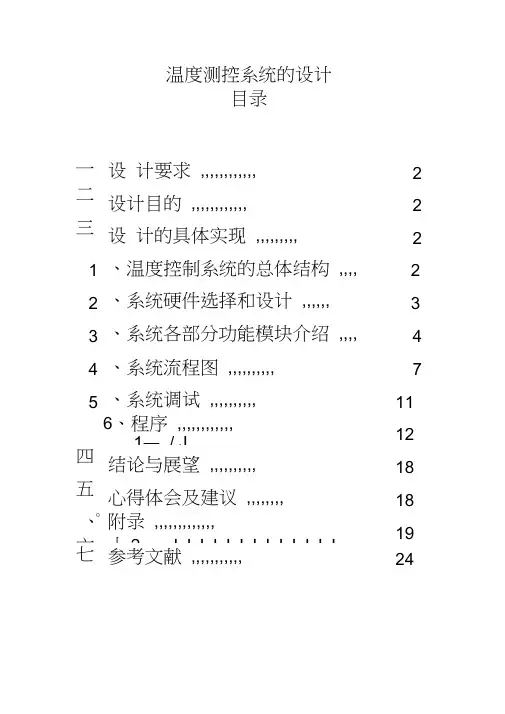
温度测控系统的设计目录一、设计要求,,,,,,,,,,,,2二、设计目的,,,,,,,,,,,,2三、设计的具体实现,,,,,,,,,21、温度控制系统的总体结构,,,,22、系统硬件选择和设计,,,,,,33、系统各部分功能模块介绍,,,,44、系统流程图,,,,,,,,,,75、系统调试,,,,,,,,,,116、程序,,,,,,,,,,,,1―/ J12四、结论与展望,,,,,,,,,,18五、心得体会及建议,,,,,,,,18、°六附录,,,,,,,,,,,,,丨2」J J J J J J J J J J J J J19七、参考文献,,,,,,,,,,,24、设计要求利用ADC080酥用中断式设计一个温度测控系统,在LED数码显示器上显示温度值,并对温度进行测试和控制,当检测温度达到温度上限60 T时开启风扇(即开启电机),低于下限温度30C时关闭风扇,LED 上的显示内容为:XX C (采用十进制显示)。
二、设计目的课程设计是学生理论联系实际,提高实际综合运用能力的一个保障,也是工程师基本训练的重要环节,电子信息工程专业的学生在学完了《微机原理与接口技术》课程后,已经具备了对微机系统进行设计的初步能力。
通过对一个具体微机系统软硬件系统的设计和调试,培养学生运用该课程的理论知识和技术知识解决工程实际问题的能力,学习微机系统的设计方法:学生通过对实验室系统的实验调试,进一步培养和提高科学实验能力,因此,本课程设计为学生提供了一个良好的理论联系实际的机会和场所,有利于为学生树立微机是一个整体系统的概念,同时加强了学生编制和调试程序的能力,进一步培养学生的独立工作能力。
因此,它是教数学计划中必不可少的重要环节。
本课程是电子信息工程专业的必修课。
本设计的目的是以8086微处理器为控制器,将温度传感器输出的小信号经过放大和低通滤波后,送至A/D 转换器;微控制器实时采集、显示温度值(要求以摄氏度显示),同时系统还应可设定、控制温度值,使系统工作在设定温度。
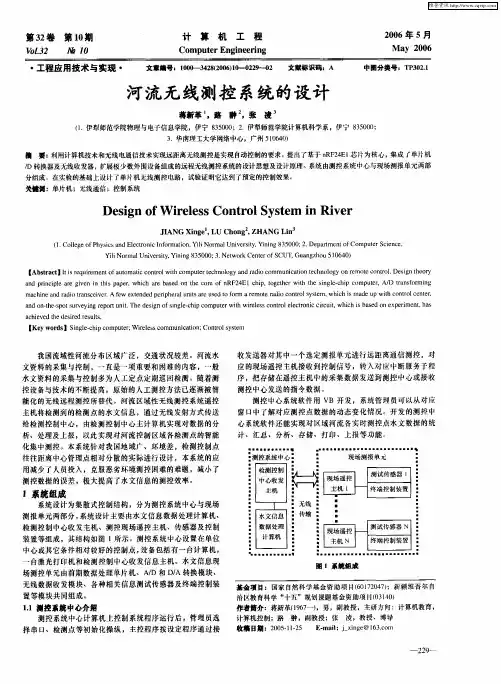
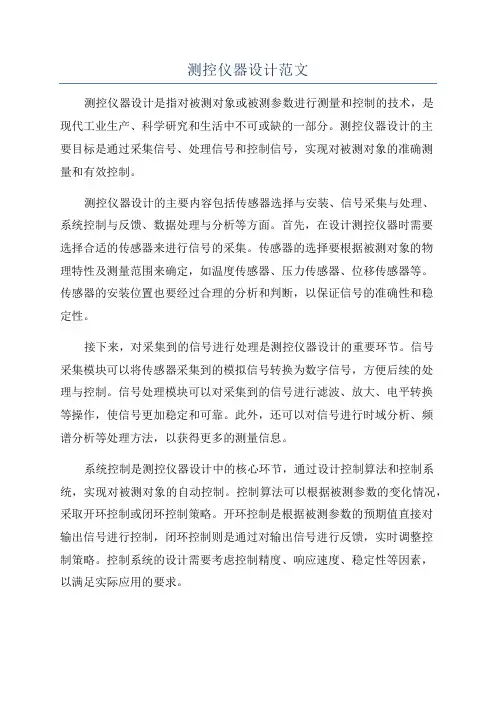
测控仪器设计范文测控仪器设计是指对被测对象或被测参数进行测量和控制的技术,是现代工业生产、科学研究和生活中不可或缺的一部分。
测控仪器设计的主要目标是通过采集信号、处理信号和控制信号,实现对被测对象的准确测量和有效控制。
测控仪器设计的主要内容包括传感器选择与安装、信号采集与处理、系统控制与反馈、数据处理与分析等方面。
首先,在设计测控仪器时需要选择合适的传感器来进行信号的采集。
传感器的选择要根据被测对象的物理特性及测量范围来确定,如温度传感器、压力传感器、位移传感器等。
传感器的安装位置也要经过合理的分析和判断,以保证信号的准确性和稳定性。
接下来,对采集到的信号进行处理是测控仪器设计的重要环节。
信号采集模块可以将传感器采集到的模拟信号转换为数字信号,方便后续的处理与控制。
信号处理模块可以对采集到的信号进行滤波、放大、电平转换等操作,使信号更加稳定和可靠。
此外,还可以对信号进行时域分析、频谱分析等处理方法,以获得更多的测量信息。
系统控制是测控仪器设计中的核心环节,通过设计控制算法和控制系统,实现对被测对象的自动控制。
控制算法可以根据被测参数的变化情况,采取开环控制或闭环控制策略。
开环控制是根据被测参数的预期值直接对输出信号进行控制,闭环控制则是通过对输出信号进行反馈,实时调整控制策略。
控制系统的设计需要考虑控制精度、响应速度、稳定性等因素,以满足实际应用的要求。
最后,数据处理与分析是测控仪器设计中的关键环节。
通过采集到的数据进行统计分析、曲线拟合、数据采样与存储等操作,可以得到更加详细和全面的测量结果。
数据处理与分析也是测控仪器设计的一个创新点,通过优化算法和数据处理方法,可以提高测量与控制系统的性能和效果。
总的来说,测控仪器设计涉及到多个方面的知识和技术,需要综合考虑被测对象的特性、测量参数的要求、信号处理与控制方法等因素。
科学、合理、可靠的测控仪器设计可以提高工业生产效率、减少资源浪费、保证产品质量,为科学研究和生活提供有力支持。
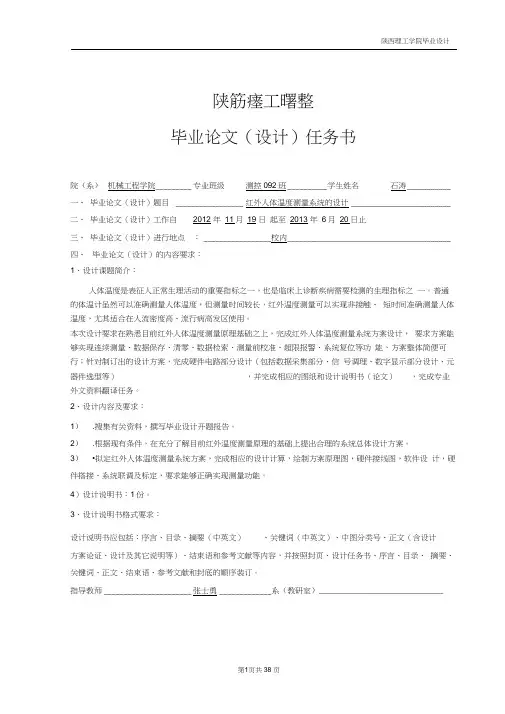
陕筋瘗工曙整毕业论文(设计)任务书院(系)机械工程学院_________ 专业班级测控092班__________ 学生姓名石涛___________一、毕业论文(设计)题目_________________ 红外人体温度测量系统的设计_________________________二、毕业论文(设计)工作自2012 年11月19 日起至2013 年6月20日止三、毕业论文(设计)进行地点:_________________ 校内_________________________________________四、毕业论文(设计)的内容要求:1、设计课题简介:人体温度是表征人正常生理活动的重要指标之一,也是临床上诊断疾病需要检测的生理指标之一。
普通的体温计虽然可以准确测量人体温度,但测量时间较长,红外温度测量可以实现非接触、短时间准确测量人体温度,尤其适合在人流密度高、流行病高发区使用。
本次设计要求在熟悉目前红外人体温度测量原理基础之上,完成红外人体温度测量系统方案设计,要求方案能够实现连续测量、数据保存、清零、数据检索、测量前校准、超限报警、系统复位等功能,方案整体简便可行;针对制订出的设计方案,完成硬件电路部分设计(包括数据采集部分、信号调理、数字显示部分设计、元器件选型等),并完成相应的图纸和设计说明书(论文),完成专业外文资料翻译任务。
2、设计内容及要求:1).搜集有关资料,撰写毕业设计开题报告。
2).根据现有条件,在充分了解目前红外温度测量原理的基础上提出合理的系统总体设计方案。
3)•拟定红外人体温度测量系统方案,完成相应的设计计算,绘制方案原理图,硬件接线图,软件设计,硬件搭接、系统联调及标定,要求能够正确实现测量功能。
4)设计说明书:1份。
3、设计说明书格式要求:设计说明书应包括:序言、目录、摘要(中英文)、关键词(中英文)、中图分类号、正文(含设计方案论证、设计及其它说明等)、结束语和参考文献等内容,并按照封页、设计任务书、序言、目录、摘要、关键词、正文、结束语、参考文献和封底的顺序装订。

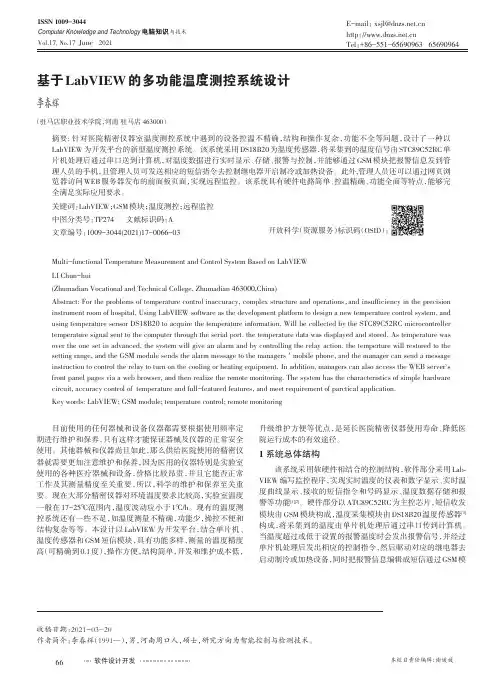
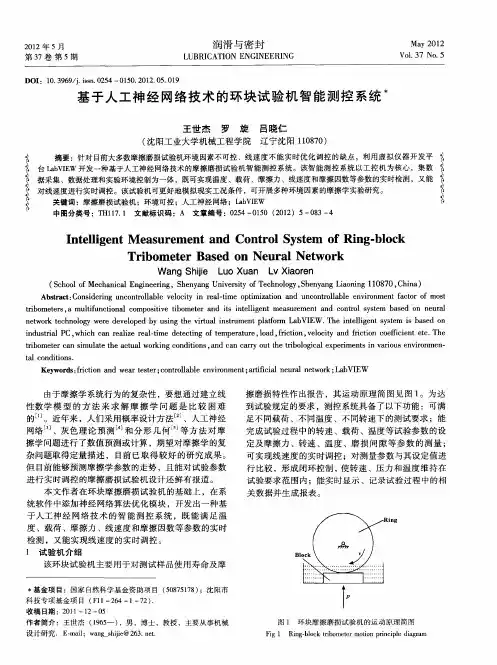
工程应用软件上机实训报告学院: 机电工程学院专业: 测控技术与仪器班级:学号:姓名:时间:目录1 任务 (2)2 所用设备 (2)3 设计过程 (2)3.1原理图的绘制 (2)3.1.1 单片机89C51芯片的绘制 (2)3.1.2 按键电路 (3)3.1.3 复位电路 (3)3.1.4 晶振电路 (4)3.1.5 蜂鸣器电路 (4)3.1.6 数码管显示电路 (4)3.1.7总原理图 (5)3.2 PCB板的生成 (6)3.2.1数码管的封装 (6)3.2.2各元器件的封装号 (6)3.2.3 PCB图 (7)4 结论 (7)5参考文献 (7)实训报告1、任务1.熟悉PROTEL的基本操作。
2.掌握用PROTEL绘制原理图的基本方法3.掌握用PROTEL制作PCB板的方法4.设计一个89C51单片机最小系统系统, 其中包括晶振电路、按键复位电路、两位数码管、一个蜂鸣器、两个按键输入。
2.所用设备1.WINDOWS XP环境2.PROTEL 99 SE软件3.设计过程3.1原理图的绘制1、首先启动PROTEL 99 SE软件;在File>New中新建一个名为YY.ddb的数据库文件, 并将其设置合适的保存位置;4、3.双击Documents文件夹, 再次选择File>New菜单, 弹出New Document对话框。
双击其中的Schematic Document图标, 新建一个名为Sheet1.Sch的原理图文件;5、双击原理图子文档, 启动原理图编辑器;6、添加元件库, 需要的有Miscellaneous Devices.ddb;添加元件, 手动编辑自己想要的元件并导入元件库, 本次设计编辑了一个单片机89C51元器件;7、连接线路, 形成原理图。
3.1.1 单片机89C51芯片的绘制在Documents文件夹中选择File>New菜单, 弹出New Document对话框。
新型电机综合性能自动测试系统的研制与研究卢慧芬;卢荻;沈若凡;许越华;赵建勇【摘要】This paper introduces an integration of WT1 600 digital wattmeter and JN338A torque transducer in a system for testing overall performance of new types of motors,which can measure their characteristic parameters such as voltage,current,torque,speed and power.This testing system combines effectively hardware such as IPC,signal collecting card and sensor and application programs such as those for data collection and analysis,and user graphic interface,so as to perform good automatic measurement of the data on the characteristic points of new types of motors such as input and output parameters,and improve the testing efficiency and accuracy. Application results indicate easy operation,and safety and reliability of the testing system developed.It has the potential for engineering application as it satisfies the requirements on the testing of new types of motors.The system has been successfully applied on the platform of motor and electrical appliances of the Electrical College of Zhejiang University.%介绍了 WT1600数字功率计与 JN338A 型转矩传感器在新型电机综合性能检测设备系统中的集成,可以测量电压、电流、转矩、转速、功率等电机特性参数。